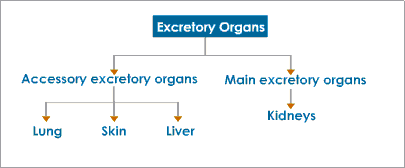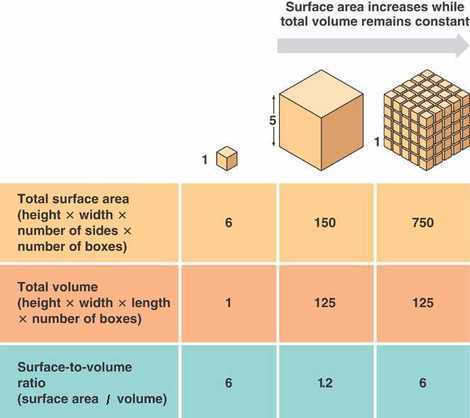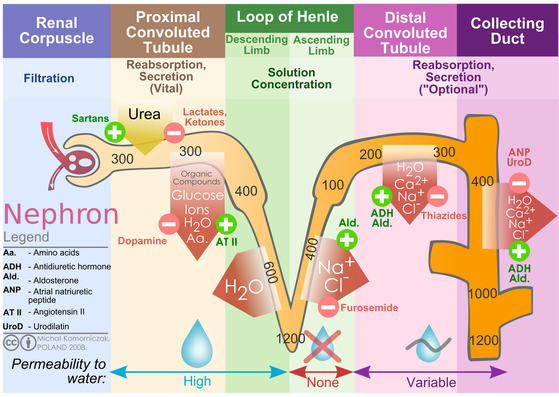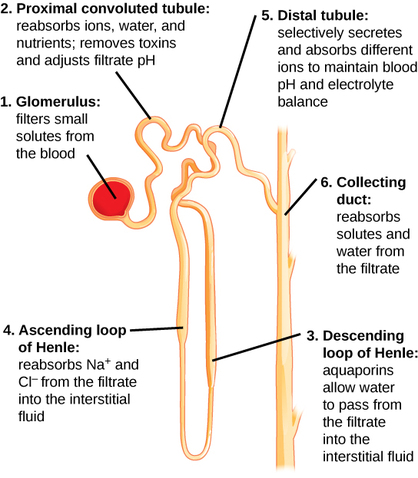topic 4: water balance
State that homeostasis is the maintenance of a constant internal environment and that body water content is an example of homeostasis
State: Give a specific name, value or other brief answer without explanation or calculation.
State: Give a specific name, value or other brief answer without explanation or calculation.
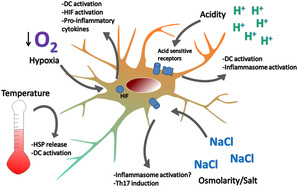
The human organism consists of cells working together to maintain the organism. While cells may perform different functions, all the cells are quite similar in their metabolic activity. Maintaining a constant internal environment with all that the cells need to survive is necessary for the well-being of individual cells and the well-being of the entire body. Homeostasis is the control of internal conditions, be it temperature, specific blood conditions or other variables within living organisms.
The purpose of homeostasis is to provide a consistent internal environment for proper enzymatic activities. Each process, or reaction, has a desirable peak environment. Influences, such as an external influence, can cause deviation away from this norm level and the body will correct this change – this is called negative feedback.
Negative feedback is the most common type of reaction, because it is only natural to rectify a potential problem, but there is also positive feedback. This is when the body will push itself further away from the normal level.
The purpose of homeostasis is to provide a consistent internal environment for proper enzymatic activities. Each process, or reaction, has a desirable peak environment. Influences, such as an external influence, can cause deviation away from this norm level and the body will correct this change – this is called negative feedback.
Negative feedback is the most common type of reaction, because it is only natural to rectify a potential problem, but there is also positive feedback. This is when the body will push itself further away from the normal level.
Explain how organisms are able to respond to changes in their environment
Explain: Give a detailed account.
Explain: Give a detailed account.
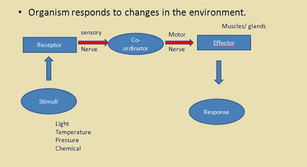
Changes occur in the external environment of all organisms on Earth. Species have changed over thousands of years in a changing environment. Multicellular organisms rely on body systems to function together so all the cells have the right conditions such as, levels of nutrients and oxygen, and also so their toxic wastes are removed. The circulatory, respiratory, digestive, excretory system in humans work together to provide a relatively stable internal environment in cells.
State that the lungs, kidneys and skin are organs of excretion
State: Give a specific name, value or other brief answer without explanation or calculation.
State: Give a specific name, value or other brief answer without explanation or calculation.
The excretory system is a passive biological system that removes excess, unnecessary or dangerous materials from an organism. This process helps maintain the homeostasis within the organism and prevent damage to the cells. It is responsible for the elimination of the waste products of metabolism as well as other liquid and gaseous wastes. As most healthy functioning organs produce metabolic and other wastes, the entire organism depends on the function of the system; however, only the organs specifically for the excretion process are considered a part of the excretory system.
Evaluate the relationship between surface area, volume and surface area to volume ratio in relationship to heat loss
Evaluate: Make an appraisal by weighing up the strengths and limitations.
Evaluate: Make an appraisal by weighing up the strengths and limitations.
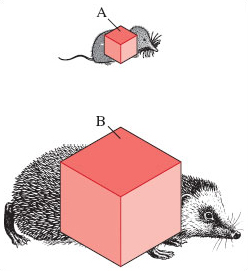 image from www.open.edu
image from www.open.edu
Small-bodied animals or plant parts (e.g., leaves) heat up and cool down faster; bigger and/or thicker bodies heat up and cool down slower. Smaller/thinner bodies have a larger surface area to volume ratio. Bodies gain and lose heat out of the surface of their body; more surface area means greater gains and losses. Bodies retain heat within their bodies; more volume means more heat retention. When the surface area is large compared to the volume (small/thin things), heat is gained and lost quickly because there is lots of surface area to gain and lose heat and relatively little volume to retain heat.
Advantages and Disadvantages to being Large:
Advantages and Disadvantages to being Large:
- Heat is gained and lost more slowly so, for example, on a hot summer day, the a large animal may never reach lethal temperatures by the time the sun sets.
- Because heat is lost more slowly, the animal doesn't have to replace lost heat as quickly; therefore, the animal doesn't have to eat as much compared to its body weight (e.g., only has to eat 1/4 its body weight). However, it usually does have to eat more total food than a smaller animal.
- Heat is gained and lost faster so, for example, on a hot summer day, a small leaf (less than about 1 square centimeter) will shed heat as fast as it acquires heat; therefore the leaf will never reach temperatures higher than air temperature (compared to a large, thick leaf that acquires a heat load and can reach very high, lethal temperatures).
- Because heat is lost faster, the animal has to eat faster to replace the lost energy (e.g., very small mammals may eat up to 4 times their body weight each day).
Explain the concept of control by negative feedback in homeostasis with reference to water balance
Explain: Give a detailed account
Explain: Give a detailed account
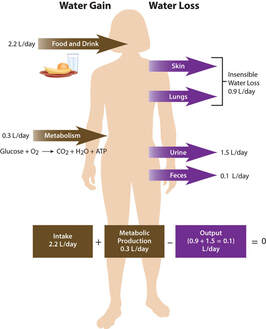 image from www.blendspace.com
image from www.blendspace.com
The concept of control by negative feedback is a key mechanism by which the body maintains homeostasis, or a relatively constant internal environment. Negative feedback occurs when a change in a physiological variable triggers a response that counteracts the change, bringing the variable back to its set point or normal range.
Water balance is one example of a physiological process that is controlled by negative feedback. The body needs to maintain a balance between water intake and water loss in order to maintain proper hydration and function properly.
When the body becomes dehydrated, for example, the concentration of solutes in the blood increases. This triggers the release of antidiuretic hormone (ADH) from the pituitary gland, which signals the kidneys to reabsorb more water from urine and return it to the bloodstream. This reduces the concentration of solutes in the blood and helps to restore normal water balance in the body.
Conversely, when the body has excess water, the concentration of solutes in the blood decreases. This triggers a decrease in ADH release, which signals the kidneys to excrete more water in urine and restore normal water balance.
In this way, the body uses negative feedback to maintain a relatively constant water balance, and prevent dehydration or overhydration. Other physiological processes, such as blood glucose regulation, body temperature regulation, and pH balance, also use negative feedback to maintain homeostasis
Water balance is one example of a physiological process that is controlled by negative feedback. The body needs to maintain a balance between water intake and water loss in order to maintain proper hydration and function properly.
When the body becomes dehydrated, for example, the concentration of solutes in the blood increases. This triggers the release of antidiuretic hormone (ADH) from the pituitary gland, which signals the kidneys to reabsorb more water from urine and return it to the bloodstream. This reduces the concentration of solutes in the blood and helps to restore normal water balance in the body.
Conversely, when the body has excess water, the concentration of solutes in the blood decreases. This triggers a decrease in ADH release, which signals the kidneys to excrete more water in urine and restore normal water balance.
In this way, the body uses negative feedback to maintain a relatively constant water balance, and prevent dehydration or overhydration. Other physiological processes, such as blood glucose regulation, body temperature regulation, and pH balance, also use negative feedback to maintain homeostasis
Describe the structure of the urinary system, including the kidneys, ureters, bladder and urethra
Describe: Give a detailed account or picture of a situation, event, pattern or process.
Describe: Give a detailed account or picture of a situation, event, pattern or process.
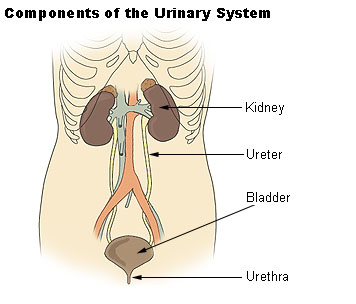 image from training.seer.cancer.gov
image from training.seer.cancer.gov
The kidneys, ureters, bladder, and urethra work together to remove waste products from the blood. The nephrons of the kidneys are involved in filtering the blood and urine formation. The ureters, bladder, and urethra are responsible for eliminating urine from the body. The kidneys also play an important role in regulating blood cell production by producing the hormone erythropoietin to stimulate the red bone marrow to produce red blood cells. They also help to control blood pressure by producing the hormone renin, which helps regulate blood pressure
Outline the function of the kidneys
Outline: Give brief account
Outline: Give brief account
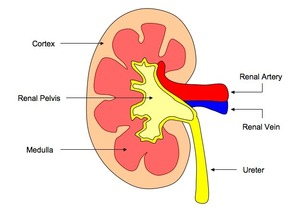 image from www.ib.bioninja.com.au
image from www.ib.bioninja.com.au
The kidneys perform a wide range of vital functions in the healthy body, such as:
- Removing wastes and water from the blood
- Balancing chemicals in your body
- Releasing hormones
- Helping control blood pressure
- Helping to produce red blood cells
- Producing vitamin D, which keeps the bones strong and healthy
Describe the structure of a nephron, to include Bowman’s capsule and glomerulus, convoluted tubules, loop of Henlé and collecting duct
Describe: Give a detailed account or picture of a situation, event, pattern or process
Describe: Give a detailed account or picture of a situation, event, pattern or process
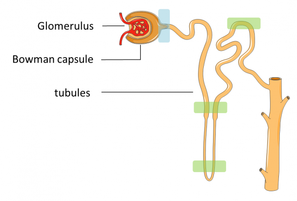 image from www.eurostemcell.org
image from www.eurostemcell.org
The nephron is the tiny filtering structure in your kidneys. Each of your kidneys contain more than a million tiny filtering nephrons that help clean your blood.
The 4 regions are:
Function of the Nephrons
Remove excess water,waste and other substances from your blood.
Return substances like sodium, potassium or phosphorus whenever any of these substances run low in your body.
Each nephron is composed of two main structures: the glomerulus and renal (kidney) tubule.
The 4 regions are:
- (a) Bowman's capsule
- (b) Proximal convoluted tubule (PCT)
- (c) Loop of Henle
- (d) Distal convoluted tubule (DCT)
Function of the Nephrons
Remove excess water,waste and other substances from your blood.
Return substances like sodium, potassium or phosphorus whenever any of these substances run low in your body.
Each nephron is composed of two main structures: the glomerulus and renal (kidney) tubule.
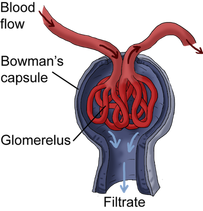 image from www.shmoop.com
image from www.shmoop.com
The Glomerulus
The glomerulus is a tiny blood vessel or capillary, which looks like a ball of yarn. Actual filtering of your blood occurs in the glomerulus.
Each of your glomeruli acts like a sieve that helps keep normal proteins and cells in your bloodstream and allows wastes, excess fluid and other substances to pass.
The glomerulus is a tiny blood vessel or capillary, which looks like a ball of yarn. Actual filtering of your blood occurs in the glomerulus.
Each of your glomeruli acts like a sieve that helps keep normal proteins and cells in your bloodstream and allows wastes, excess fluid and other substances to pass.
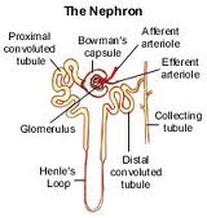 image from dlb-network.com
image from dlb-network.com
The Tubule
The tubule, also called renal or kidney tubule, is a tiny tube where the wastes, extra fluid and other recyclable substances like sodium and potassium filtered out from the glomerulus pass through.
Your kidneys measure out chemicals like sodium, phosphorus, and potassium and release them back to the blood to return to the body when need arises. In this way, your kidneys regulate the your body’s level of these substances. The right balance is necessary for you to function properly.
The tubule, also called renal or kidney tubule, is a tiny tube where the wastes, extra fluid and other recyclable substances like sodium and potassium filtered out from the glomerulus pass through.
Your kidneys measure out chemicals like sodium, phosphorus, and potassium and release them back to the blood to return to the body when need arises. In this way, your kidneys regulate the your body’s level of these substances. The right balance is necessary for you to function properly.
Describe ultrafiltration in the Bowman’s capsule and the composition of the glomerular filtrate
Describe: Give a detailed account or picture of a situation, event, pattern or process
Describe: Give a detailed account or picture of a situation, event, pattern or process
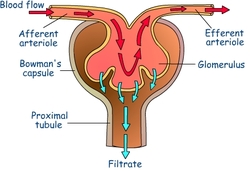 image from danielscienceblogg.blogspot.com
image from danielscienceblogg.blogspot.com
The Bowman's capsule is where the filtration process begins This process is know as ultrafiltration.
Blood enters the kidney through the blood vessel called afferent arteriole. The blood is under high pressure. Blood vessels start to bend and twist into and become the glomerulus. The blood then comes out through the blood vessel efferent arteriole in which the diameter of this vessel is smaller and more narrow than the afferent arteriole's. The consequence of narrowed vessels is the increase of blood pressure. In other words, the blood pressure increases in the glomerulus. The blood has been filtered due to high pressure because of the smaller area of the blood vessel. The blood has been filtered through undergoing high pressure due to the narrowing glomerulus, which forces in plasma out from the blood into the Bowman's capsule .
Blood enters the kidney through the blood vessel called afferent arteriole. The blood is under high pressure. Blood vessels start to bend and twist into and become the glomerulus. The blood then comes out through the blood vessel efferent arteriole in which the diameter of this vessel is smaller and more narrow than the afferent arteriole's. The consequence of narrowed vessels is the increase of blood pressure. In other words, the blood pressure increases in the glomerulus. The blood has been filtered due to high pressure because of the smaller area of the blood vessel. The blood has been filtered through undergoing high pressure due to the narrowing glomerulus, which forces in plasma out from the blood into the Bowman's capsule .
State that selective reabsorption of glucose occurs at the proximal convoluted tubule
State: Give a specific name, value or other brief answer without explanation or calculation
State: Give a specific name, value or other brief answer without explanation or calculation
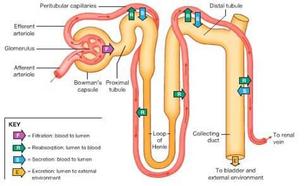 image from www.studyblue.com
image from www.studyblue.com
Selective reabsorption is the reabsorption of specific substances from the glomerulus filtrate back to the blood. Remember, filtration happens in the Bowman's capsule and the glomerulus filtrate contains the glucose, water, salts, amino acids and urea. This may seem strange because it has been removed from the blood and now going to be put back into the blood.
Glucose is removed from the glomerulus filtrate in the proximal convoluted tubule just before the Loop of Henle .
Glucose is usually not found in urine. However, if urine tests positive for glucose, the individual may have a condition known as diabetes.
Glucose is removed from the glomerulus filtrate in the proximal convoluted tubule just before the Loop of Henle .
Glucose is usually not found in urine. However, if urine tests positive for glucose, the individual may have a condition known as diabetes.
Outline how water is reabsorbed into the blood from the collecting duct and the role of ADH in regulating the water content of the blood
Outline: Give a brief account.
Outline: Give a brief account.
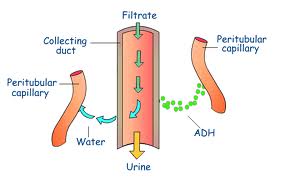 image from andrewbiology.blogspot.com
image from andrewbiology.blogspot.com
The amount of water in the blood must be kept the same all the time to avoid cell damage as a result of osmosis. There has to be a balance between the amount of water gained (from your diet though drinks and food and the water produced by cellular respiration) and the amount of water lost by the body (in sweating, evaporation, faeces and urine).
This is achieved by the action of the hormone ADH (anti-diuretic hormone).
The hypothalamus, detects that there is not enough water in the blood. The hypothalamus sends a message to the pituitary gland which releases ADH. This travels in the blood to your kidneys and affects the tubules so more water is reabsorbed into your blood. As a result you make a smaller volume of more concentrated urine. The level of water in your blood increases until it is back to normal.
Sometimes the level of water in your blood goes up because, for example, it is cold and you have not been losing any water through sweating or because you have had a lot to drink. The hypothalamus detects the change and sends a message to the pituitary. The release of ADH into the blood is slowed down or even stopped. Without ADH the kidneys will not save as much water and you produce large volumes of dilute urine. The level of water in the blood falls back to the normal level.
This is an example of negative feedback. As the level of water in the blood falls, negative feedback ensures that the amount of ADH rises. As the level of water in the blood rises negative feedback ensures that the amount of ADH falls
This is achieved by the action of the hormone ADH (anti-diuretic hormone).
The hypothalamus, detects that there is not enough water in the blood. The hypothalamus sends a message to the pituitary gland which releases ADH. This travels in the blood to your kidneys and affects the tubules so more water is reabsorbed into your blood. As a result you make a smaller volume of more concentrated urine. The level of water in your blood increases until it is back to normal.
Sometimes the level of water in your blood goes up because, for example, it is cold and you have not been losing any water through sweating or because you have had a lot to drink. The hypothalamus detects the change and sends a message to the pituitary. The release of ADH into the blood is slowed down or even stopped. Without ADH the kidneys will not save as much water and you produce large volumes of dilute urine. The level of water in the blood falls back to the normal level.
This is an example of negative feedback. As the level of water in the blood falls, negative feedback ensures that the amount of ADH rises. As the level of water in the blood rises negative feedback ensures that the amount of ADH falls
Key Terms:
|
homeostasis
excretion urine metabolism nitrogen osmoregulation urea |
ureters
urethra sphincter ADH hypothalamus water |
cortex
nephrons renal artery renal vein bladder |
loop of Henle
Bowman capsule glomerulus collecting duct filtrate arterioles ultrafiltration |
selective reabsorption
negative feedback thermoregulatory centre medulla bladder |
Class Materials:
Part 3 The Kidney and Water Control
How Much Is That Kidney In The Window WebWalk
Homeostasis and Sports Drinks WebWalk
Kidney Transplant vs Dialysis (in class assignment)
Choose a single animal (other than human) and describe how is carries out its homeostasis with respect to water and salt balance. Provide a detailed drawing or image (reference source) to illustrate your answer. please include diagrams or pictures may be right from the web. Please look at the Malpighian diagram to help you answer the questions
Kidney Practical
Useful Links:
Osmoregulation Review from Shmoop
Water Balance and The Kidney from Shmoop
Click here for a great animation on Positive and Negative Feedback
Biology 4 Kids
McGraw Hill Positive and Negative Feedback animation
Great Kidney animation from Interactive Human
A great review from KScience on ADH and the Kidneys
Video clip on Fight or Flight Response from
Video Clips:
Hank takes us on the fascinating journey through our excretory system to learn how our kidneys make pee.
Paul Andersen explains how organisms regulate their internal osmolarity or not. He starts with a brief description of osmosis and why it is important for animal cell to be surrounded by an isotonic solution. He then explains how freshwater and saltwater fish osmoregulate. He finally discussed the nephron within the kidney as an osmoregulatory organ. He explains how the loop of Henle sets up a gradient which is used to reclaim or remove water with the use of the antidiuretic hormone (or ADH)
